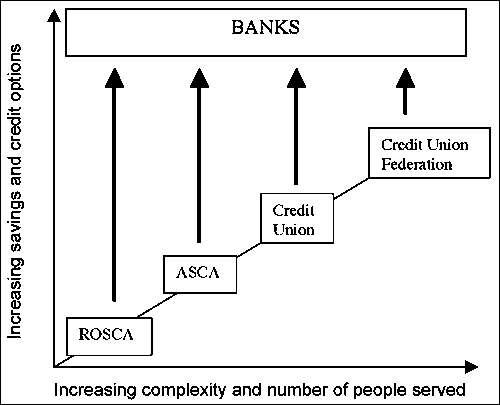Types of Savings groups. A Journey through ROSCAs, ASCAs, SACCOs, and More

In this article, we will navigate through the intricacies of various types of savings groups, shedding light on their purposes, advantages, and disadvantages. Our exploration will encompass Cash Rounds (ROSCAs), Accumulative Savings and Credit Associations (ASCAs), Savings and Credit Cooperatives (SACCOs), and even touch upon the unique dynamics of Investment Clubs and Village Savings and Loans Associations (VSLAs).
Outline of what we are going to cover
- What is a savings group
- Cash rounds(ROSCAs)
- ASCAs
- SACCOs Credit unions
- How about VSLAs and Investment Clubs?
Understanding Savings Groups
What is a savings group?
At its core, a savings group is a collective effort where members pool a predetermined amount of money periodically, aiming to accumulate significant sums for diverse endeavours. The beauty lies in the diversity of savings groups, each offering unique features and benefits to its members. While there might be many types of savings groups with each working differently and each having a different name in a different country, they all step from major variations.
- ROSCAs
- ASCAs
- SACCOs
Cash Rounds (ROSCAs)
The informal setting of a ROSCA, or Rotating Savings and Credit Association set the stage for a simple yet effective model of saving. Also known as cash rounds or merry-go-rounds, ROSCAs operate on a simple premise – members contribute predetermined amounts at regular intervals, and the collective fund is circulated among the group. This continues until each member has received their share, and the cycle may repeat. These have different names in different countries
How does a Cash Round(ROSCA) work?
- Group members contribute predetermined amounts daily, weekly, or monthly.
- The collected money is given to a single member.
- The contribution and distribution cycle repeats until all members receive the fund once.
- The group may choose to initiate a new cycle after the last member receives the fund.
Advantages and Disadvantages of Cash Rounds
Pros:
- No need for extensive record-keeping.
- Immediate distribution of funds upon collection so money storage is not required.
Cons:
- Risk of default by early recipients.
- Less flexibility for members in urgent need of funds.
Lumpsum distribution methods: In a cash round, various lump-sum distribution methods, such as strict turns, alphabetical order, lottery draws, or auctions (Lumpsum is sold to the member who is willing to pay the most for it) , add spice to the ROSCA dynamics.
Accumulative Savings and Credit Associations (ASCAs)
ASCAs offer a departure from the ROSCA model by accumulating savings over time instead of distributing them at each meeting. Members contribute fixed sums regularly, and when a substantial fund is amassed, the group may offer loans to members, fostering financial growth.
How does a Cumulative Savings and Credit Association work?
- Members contribute fixed amounts periodically, such as weekly or monthly.
- Loans are provided to members once a significant fund is accumulated.
- Loan repayment can be in instalments or as a lump sum at the end of the loan period.
- The group periodically closes accounts, distributing accumulated savings and profits back to members.
Advantages and Disadvantages of ASCAs
Pros:
- Accumulation of larger sums over time.
- Flexible loan and savings options.
Cons:
- Risk of default by members.
- Requires safekeeping and record-keeping
Lumpsum distribution methods in an ASCAs. ASCAs typically distribute funds annually, including savings and a portion of the income generated from loans and other group activities.
Savings and Credit Cooperatives (SACCOs)
Known also as Credit Unions, SACCOs mirror ASCAs but on a larger scale, serving hundreds of members. Governed by country laws, they provide a wide array of savings and credit options, utilizing members' deposits for loans. SACCOs maintain accounts in banks, ensuring security.
In this article, we explore the difference between a sacco and a savings group
How do Credit Unions (SACCOs) work?
- A credit union uses members' savings deposits to provide loans.
- Interest from loans is used to give dividends to members.
- Members purchase at least one member share, acting as a certificate of ownership.
- Individual savings accounts allow members to deposit and withdraw freely.
- Membership Shares: Every individual must acquire a minimum of one membership share to gain entry into the savings group. This share serves as a certificate of ownership within the group and can be sold should a member decide to exit the SACCO. The SACCO utilizes these shares to establish an initial pool of funds.
- Personal Savings Accounts: Commonly provided by most SACCOs, individual savings accounts permit members to deposit any amount at their discretion, with the freedom to withdraw funds as needed. However, it's important to note that savings in individual accounts do not accrue interest, as they are not employed for extending loans.
Advantages and Disadvantages of SACCOs:
Pros:
- A larger membership translates to more substantial fund pools.
- Safe deposit facilities and voluntary savings.
- Potential dividends for members if the SACCO generates a surplus.
Cons:
- Complex bookkeeping and accounting due to a large member base.
- Possibility of favouritism because there is no close monitoring by members
Others
Investment Clubs: Both the Uganda Investment Authority and Investopedia define an investment club as a collective of individuals who combine their funds for investment purposes. Members of the investment club participate in voting to determine profitable ventures for their pooled investments. While investment clubs may appear distinct, they share similarities with SACCOs in pooling funds from members. However, they differ in that, instead of disbursing loans to members, they invest in ventures to generate profits for the club.
Village Savings and Loans Associations (VSLAs): VSL Associates, committed to disseminating the VSLA model globally, defines VSLAs as groups of individuals who regularly save and access small loans from their savings. The group's activities typically span one year, after which the accumulated savings and profits are distributed back to the members of the group. Despite not seeming to fit the conventional savings group model, Village Savings and Loan Associations (VSLAs) represent a variant of ASCA (Accumulative Savings and Credit Association). CARE, an organization dedicated to combating poverty and promoting social justice, pioneered VSLAs in rural Niger in 1993.
References

https://www.worldvision.de/sites/worldvision.de/files/pdf/TP11_Impact_Accumulating_MB.pdf



